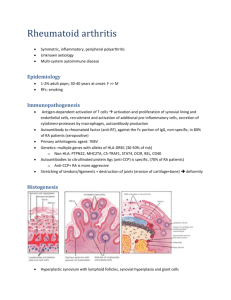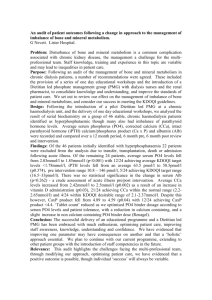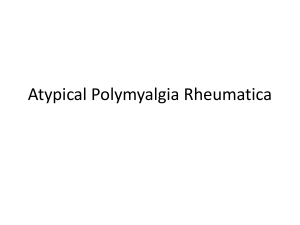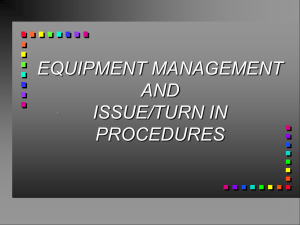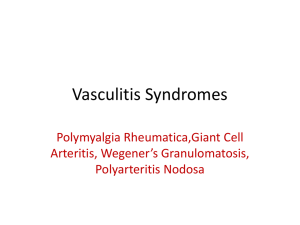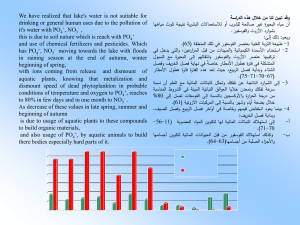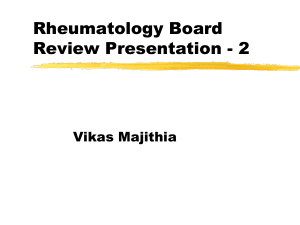Achy shoulders and a very high CRP
advertisement
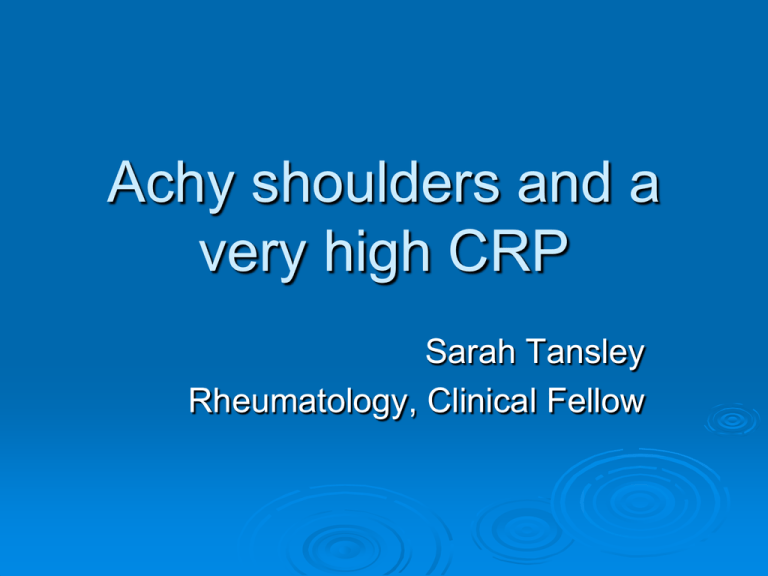
Achy shoulders and a very high CRP Sarah Tansley Rheumatology, Clinical Fellow Case discussion A case of polymyalgic onset rheumatoid arthritis was discussed – details removed for confidentiality purposes. PMR diagnosis Core Inclusion criteria Age > 50 Bilateral shoulder or pelvic girdle aching or both Morning stiffness >45 minutes Evidence of acute phase response No active cancer, active infection or active GCA No urgency to start steroids – can investigate first Factors which Increase the likelihood of a non-PMR diagnosis Age <60 years Chronic Onset Lack of shoulder involvement Lack of inflammatory stiffness Normal or very high CRP Peripheral arthritis Systemic symptoms, weight loss, neurological signs Incomplete or non-response to steroids 15mg Prednisolone should result in >70% improvement within 1 week and normalisation of inflammatory markers within 4 weeks Who to refer BSR guidelines recommend specialist referral when Age <60 Chronic onset >2 months Lack of shoulder involvement Lack of inflammatory stiffness Prominent systemic features; weight loss, night pain, neurological signs Features of other rheumatic disease Normal or extremely high acute phase response Treatment dilemmas (inadequate response to steroids, inability to reduce steroids, contraindication to steroids etc) RA diagnosis Aim for early diagnosis and treatment but lack of features of established disease can cause difficulty Considerable variability in presenting symptoms and lab results History Polyarticular involvement –may be small number of joints initially Morning stiffness (>30 minutes) suggests inflammatory joint pain Chronicity Examination Joint tenderness MCP, MTP, wrists RA nodules, not usually seen until later Upper and lower extremity involvement Synovitis Rheumatoid Arthritis Investigations No single diagnostic test Serology RF • • • • Positive in 70-80% of patients with RA May be negative, especially early Also seen in other conditions eg Sjogrens Syndrome Positive in 5-10% of healthy individuals Anti- CCP Abs • As sensitive • Much more specific Rheumatoid Arthritis Investigations Inflammatory markers Full blood count Non-specific Useful for distinguishing inflammatory conditions from non-inflammatory Anaemia of chronic disease, leucocytosis, thrombocytosis Radiology Erosions of cartilage and bone Presence more useful diagnostically with increasing duration of disease Radiology ACR/EULAR classification criteria Score Designed to classify patients as RA earlier for purpose of clinical trials – not diagnostic criteria Still useful, several differences from 1987 criteria which aimed to classify people with established disease Target population At least 1 joint with definite synovitis/swelling Synovitis not better explained by another disease Score >6 classified as RA Joint Involvement 1 large 0 2-10 large 1 1-3 small 2 4-10 small 3 >10 joints 4 Serology Negative RF & anti-CCP Ab 0 Low positive RF or anti-CCP Ab 2 High positive RF or anti-CCP Ab 3 Acute Phase Reactants Normal CRP & ESR 0 Abnormal CRP or ESR 1 Duration of Symptoms < 6 weeks 0 >6 weeks 1 Polymyalgic onset RA Bajocchi et al 2000 LO-RA vs YO-RA • Polymyalgic symptoms more common in LO RA • Higher frequency of shoulder involvement in LO RA Lopez-Hoyos et al 2004 Anti-CCP Abs in differential diagnosis of RA vs PMR • 65% LO RA anti-CCP Ab +ve • No PMR patients anti-CCP Ab +ve • Polymyalgic onset RA 2/10 anti-CCP +ve Polymyalgic onset RA Gran, Mykebust 1999 Incidence and Characteristics of peripheral arthritis in PMR & TA • 231 patients prospectively studied 1987-1993 • All ?PMR/TA in Norwegian county referred to rheumatology before treatment • Followed throughout the disease course 187 ‘pure’ PMR 38.5% developed peripheral arthritis 11 developed RA (4.8% 6 female and 5 male) Polymyalgic RA Mean duration of PMR at RA diagnosis was 63.2 months 5/8 patients had erosive x-ray changes 6/11 patients had positive RF (all negative initially) Mean CRP higher at diagnosis among those who developed arthritis (88.6 vs 59.7) Polymyalgic onset RA Pease et al 2009 Prospective study of 147 patients presenting with PMR & 142 patients with LO-RA Reviewed accuracy of initial diagnosis • 23% PMR patients had peripheral synovitis • In contrast to seronegative LO-RA, PMR patients younger, myalgia more frequent, PIP/MCP/wrist arthritis less frequent • Combination of wrist + MCP and/or PIP highly suggestive of RA Polymyalgic onset RA Pease et al 2005 349 patients with new onset LO-RA, PMR or TA >60 yrs • 9/171 initially diagnosed PMR changed to LO-RA • All 9 dependant on higher steroid dose than typically expected for their stage of disease • Initially synovitis suppressed by steroids but returned when dose lowered • Initial plasma viscosity higher in this group (mean of 2.0 vs 1.86) • Difficulty to distinguish may lead to delay in correct diagnosis (average 13 months) Summary Several challenges in diagnosing RA, particularly early in the disease course Variety of possible presentations Polymyalgic symptoms are common in elderly onset RA May lead to diagnostic delay No single diagnostic test; clinical history and examination important

